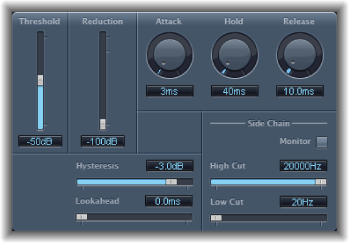Noise Gate
The Noise Gate is commonly used to suppress unwanted noise that is audible when the audio signal is at a low level. You can use it to remove background noise, crosstalk from other signal sources, and low-level hum, among other uses.
The Noise Gate works by allowing signals above the threshold level to pass unimpeded, while reducing signals below the threshold level. This effectively removes lower-level parts of the signal, while allowing the desired parts of the audio to pass.
Using the Noise Gate
In most situations, setting the Reduction slider to the lowest possible value ensures that sounds below the Threshold value are completely suppressed. Setting Reduction to a higher value attenuates low-level sounds but still allows them to pass. You can also use Reduction to boost the signal by up to 20 dB, which is useful for ducking effects.
The Attack, Hold, and Release knobs modify the dynamic response of the Noise Gate. If you want the gate to open extremely quickly, for percussive signals such as drums, set the Attack knob to a lower value. For sounds with a slow attack phase, such as string pads, set Attack to a higher value. Similarly, when working with signals that fade out gradually or that have longer reverb tails, set a higher Release knob value that allows the signal to fade out naturally.
The Hold knob determines the minimum amount of time that the gate stays open. You can use the Hold knob to prevent abrupt level changes—known as chattering—caused by rapid opening or closing of the gate.
The Hysteresis slider provides another option for preventing chattering, without needing to define a minimum Hold time. Use it to set the range between the threshold values that open and close the Noise Gate. This is useful when the signal level hovers around the Threshold level, causing the Noise Gate to switch on and off repeatedly, producing the undesirable chattering effect. The Hysteresis slider essentially sets the Noise Gate to open at the Threshold level and remain open until the level drops below another, lower, level. As long as the difference between these two values is large enough to accommodate the fluctuating level of the incoming signal, the Noise Gate can function without creating chatter. This value is always negative. Generally, −6 dB is a good place to start.
In some situations, you may find that the level of the signal you want to keep and the level of the noise signal are close, making it difficult to separate them. For example, when you are recording a drum kit and using the Noise Gate to isolate the sound of the snare drum, the hi-hat may also open the gate in many cases. To remedy this, use the side-chain controls to isolate the desired trigger signal with the High Cut and Low Cut filters.
Important: The side-chain signal is used only as a detector/trigger in this situation. The filters are used to isolate particular trigger signals in the side-chain source, but they have no influence on the actual gated signal—the audio being routed through the Noise Gate.
Click the Monitor button to hear how the High Cut and Low Cut filters will affect the incoming trigger signal.
Drag the High Cut slider to set the upper frequency. Trigger signals above this are filtered.
Drag the Low Cut slider to set the lower frequency. Trigger signals below this are filtered.
The filters allow only very high (loud) signal peaks to pass. In the drum kit example, you could remove the hi-hat signal, which is higher in frequency, with the High Cut filter and allow the snare signal to pass. Turn monitoring off to set a suitable Threshold level more easily.
